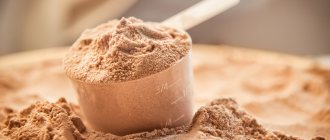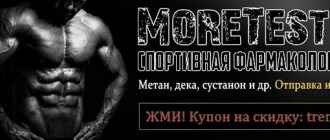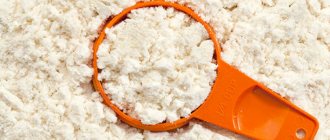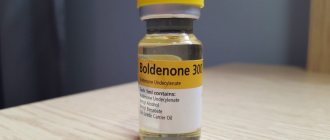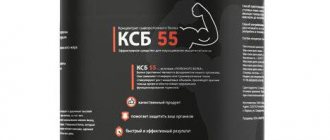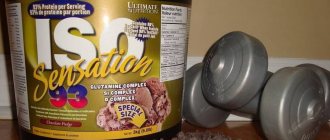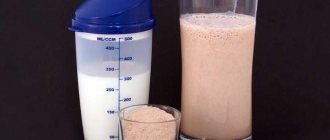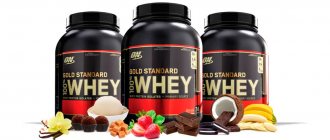Share:
Protein concentrate is a sports supplement containing purified protein. It comes in various origins: egg, whey, plant (including soy) animal. There are no artificially synthesized concentrated proteins.
Whey concentrate is the most popular and most commonly used form of protein, which is used in sports to build muscle mass and during the cutting period to accelerate weight loss. Many athletes take the supplement periodically to maintain good shape.
What is whey?
Whey and casein are two popular protein powders derived from milk . Special enzymes are added to milk to separate the curds and liquid whey . Thus, from 10 liters of milk, about 1 kg of cheese , and the remaining liquid is whey. In general, whey is found in all milk. Interestingly, whey can be obtained from the milk of any mammal in which milk is produced by the mammary gland. Even breast milk contains whey. [12]
Previously, whey was considered a waste product from cheese production and was poured into rivers or used as animal feed. However, over time the Waste Disposal Law changed , and dairy producers began to look for opportunities to use whey. They soon discovered that this “waste” was actually very important . [2]
Environmental requirements: what awaits milk processors
Following the global trend, Russian legislators are making environmental legislation for business stricter every year. Despite protests from manufacturers, several laws come into force every year that provide for new requirements or tighten existing ones.
An environmental fee has also become a permanent financial obligation for the dairy industry, which the Ministry of Natural Resources plans to consistently increase every year, including for the recycling of paper and cardboard, glass and polymer containers. In addition, a law came into force in 2020 that placed dairy processing plants in the same environmental hazard class as metallurgical and chemical plants. Amendments to the Federal Law “On Water Supply and Sanitation” also came into force, which tightened the requirements for the pollution of wastewater transferred by factories to water utilities.
According to the new legislation on water supply and sanitation, enterprises need to enter into an agreement with water utilities and comply with agreed standards on the level of pollution of wastewater supplied. Businesses will be required to develop a wastewater reduction plan, under which they will either have to build their own treatment facilities or introduce technologies and use services that reduce the concentration of pollutants in wastewater.
According to Soyuzmoloko estimates, today less than 30% of dairies have their own treatment facilities, of which only 2% are capable of providing a sufficient level of wastewater treatment. Most dairy processing enterprises actually cannot comply with the requirements established by the Rules regarding biological contaminants and will compensate water utilities for additional costs for their post-treatment. The costs of constructing full-cycle local treatment facilities are estimated at 200 to 400 million rubles.
The main source of pollution in the effluents of milk processing plants is whey, which is why the plants have long been under the close attention of environmentalists. According to specialists from Kieselmann Rus, 1 ton of whey poured into a reservoir in terms of damage caused to nature is equal to 100 tons of ordinary household wastewater.
Serum composition
What makes the serum so exceptional? Firstly, it is relatively easy to obtain, and at the same time it is rich in both nutritional and biological composition. It consists of a significant amino acid profile as well as several functional components that support the immune system. In the table below you will find all the components of the whey and their percentages. [12]
| Substances | % in serum |
| Beta-lactoglobulin | 45 – 57 % |
| Alpha-lactalbumin | 15 – 25 % |
| Immunoglobulins | 10 – 15 % |
| Glycomacropeptides | 10 – 15 % |
| Bovine serum albumin | 8 – 10 % |
| Lactoferrin | 1 % |
| Lactoperoxidase | <1 % |
Let's look at the importance of each component. [1] [5] [8]
- Beta-lactoglobulin - about 25% of its composition is BCAA amino acids, especially leucine. Branched chain amino acids BCAA promote protein synthesis, muscle growth and regeneration.
- Alpha-lactalbumin - contains about 6% of the amino acid tryptophan, which is the basis for the formation of serotonin, the so-called happiness hormone. At the same time, alpha-lactalbumin is rich in lysine, leucine, thionine and cysteine. It has the ability to bind minerals such as calcium and zinc and has a positive effect on their absorption.
- Immunoglobulins – serum contains 4 types of immunoglobulins, namely IgG, IgA, IgM and IgE, which contain antioxidants and significantly improve the functioning of the immune system.
- Glycomacropeptides are released during cheese production from digested casein. Rich in essential amino acids that promote mineral absorption.
- Bovine serum albumin has a diverse amino acid profile and promotes fat burning.
- Lactoferrin triggers the production of anti-inflammatory substances that protect the body from the development of hepatitis.
- Lactoperoxidase is important for its antimicrobial properties.
Vitamins for piglets
Any farmer wants his piglets to receive vitamins for normal growth and development not from tablets, but from feed troughs. But this is not always possible, and every farmer should know the main rules of how and in what doses to add vitamins to the animal’s diet. Their deficiency is bad, and their overdose is harmful. When buying vitamins in pharmacies, each drug comes with instructions that indicate the dosages and describe in detail how to use them.
Vitamin A is added to the diet of piglets if it does not contain green grass or high-quality hay flour. A good result will appear if you add vitamin C to the concentrated feed intended for weaned piglets (calculated per 1 kg of feed from 50 to 100 mg of vitamin C). This will help increase the average daily weight gain of piglets by up to 15%. Vitamin A includes:
- Fish oil with vitamin A;
- Fat-soluble vitamin (retinol);
- Revit;
- Vitamin A (concentrate).
Vitamin D is supplied to piglets during walks (ultraviolet irradiation) or artificially, using quartz lamps. You can buy vitamin D preparations at the pharmacy, these are:
- Fish oil with vitamin D;
- Vitamin D2 (oil or yeast concentrate);
- Oily liquid (tetravit);
- Videin - D3.
B vitamins are found in: liver, leaves, carrots, potatoes, milk, yeast, bran. If these products are absent from the diet, then a deficiency of B vitamins can affect the development of the animal. This is especially true for vitamin B2. Vitamins are added to the feed, adhering to the following standards:
For 1 kg of feed you need mg of vitamin:
- Thiamine – from 1.1 to 1.5 mg;
- Pyridoxine – 1.3 mg;
- Riboflavin – 1.6 mg;
- Niatin – from 5 to 11 mg;
- Pantothenic acid – from 7.5 to 10 mg;
- Vitamin B12–0.02 mg.
Vitamin food made from pine or spruce needles is the cheapest. An experiment was conducted, crushed pine needles were given to adults and piglets at a rate of 0.2 kg per 100 kg of weight. In addition, they were fed pine paws throughout the day. When compared with individuals who were not given pine needles, the daily growth rate of small piglets increased by 25.6%, and in adult pigs it was up to 11%.
Vitamins for Vietnamese pigs
Farmers who raise Vietnamese pigs need a product containing vitamin E. This breed of pigs often suffers from diseases of the digestive system. Therefore, vitamin E and selenium should always be present in their diet. Vitamins are administered to the animal regularly, while observing safety precautions.
- The daily dose of the vitamin is 5 IU. It is allowed to administer the vitamin 20 IU once every four days.
- Vitamin E is sold in capsules.
It is important to know! Under no circumstances should you feed Vietnamese pigs table scraps. Newfangled foods that include oats and corn are also prohibited.
Properties of whey and whey protein
The main benefit of whey protein is that it helps replenish protein and BCAA amino acids , which are key to your fitness goals. At the same time, whey protein is a complex protein source, meaning that it contains all 9 essential amino acids that the body cannot produce itself and can only obtain from food. All you need is one serving of whey protein and you will enrich your body with all 9 essential amino acids at once.
Whey is a particularly rich source of BCAA - amino acids such as leucine, isoleucine and valine , which help build and maintain muscle mass and can provide energy for long or intense workouts. Find out more about the benefits of BCAA here. Additionally, whey protein can improve performance and strength and help with weight loss . [11] [12] [13]
Whey also has many benefits for human health . Many studies confirm that whey can potentially reduce the risk of cancer, strengthen the immune system , reduce inflammation , and improve liver function in those suffering from any form of hepatitis . Whey protein also lowers blood pressure , strengthens the immune system in patients with HIV , and also helps prevent type 2 diabetes. Additionally, it increases levels of glutathione , the main antioxidant in cells. [14] [15] [16] [17] [18] [19] [20] [21]
Admission rules
Each manufacturer calculates the dosage of the supplement in its own way, but the optimal portion is considered to be 30 g of pure protein per dose. A larger amount may simply not be absorbed and have a negative impact on the liver.
It is recommended to take one to three servings per day.
If a person is accustomed to consuming small amounts of protein in food, then he should not start taking protein concentrate with large doses. The eating style needs to be changed gradually, evenly increasing portions.
If a beginner who wants to quickly build muscle or lose weight starts with large doses, he may develop adverse reactions, problems with the gastrointestinal tract and liver. The body cannot absorb more protein than it is used to.
The concentrate is taken by diluting it with any liquid. If an athlete needs to dry out, it is recommended to use plain water or low-fat dairy products. If the supplement is taken for the purpose of building muscle mass, it is better to dilute the product in juices and dairy products with normal fat content.
Types of Whey Protein
Three types of protein are produced from whey , namely whey concentrate, isolate and hydrolysate. Each contains a different percentage of protein, carbohydrates, fat and lactose, which depends on the processing of whey. However, it is important to know the main differences between different types of proteins, which will be explained below.
Whey concentrate
Whey concentrate is the least processed type of whey, containing 70-80% protein . The composition also includes lactose, fat and carbohydrates. This type of whey is produced by a filtration process and has the best taste among whey proteins. Whey concentrate is the main form of protein and is therefore suitable for athletes and those looking for a source of protein at an affordable price . It can be used as a dietary supplement before or after work, or as a protein snack between meals. [9] [10]
Whey isolate
Whey isolate contains 90-95% protein and only minimal or no lactose. It is obtained through a microfiltration process and is superior to whey concentrate because it is quickly absorbed . Ideal for people on a low carb diet and trying to lose weight. It contains a small percentage of carbohydrates and sugar. It is an ideal pre-work or post-work nutritional supplement due to its fast absorption and good digestibility. [9] [10]
Whey hydrolyzate
Whey hydrolyzate is the most expensive, but also the best type of whey protein. It ensures rapid absorption of peptides that have an anabolic effect. Produced from whey isolate by hydrolysis, which is an enzyme that breaks down whey protein into low molecular weight peptides. It has a protein content of about 90% and lactose and fat content of less than 1%. pre- and post-workout protein supplement . [9] [10]
To learn more about the types of whey protein , how to take it, and how to choose the right protein, read our article Which Protein Should I Choose? Whey concentrate, isolate or hydrolysate?
What does the concentrate contain?
The protein-vitamin-mineral concentrate must be balanced. When assessing quality, the following indicators are taken into account:
- metabolic energy;
- digestible protein and fat content;
- amount of fiber;
- composition of amino acids (lysine, tryptophan, methionine, cystine are considered critical);
- vitamin and mineral composition.
An important component of the premix is protein. Its deficiency reduces productivity and leads to overconsumption of feed. But excess protein also has a detrimental effect on the body. Excessive intake of nutrients leads to metabolic problems: protein is less absorbed. And this leads to unnecessary feeding costs. Therefore, protein is included in the BVMK from Agrovitex in the amount required for a particular category of animals.
As a rule, the percentage of input of a high-protein mixture is 5–20%. But the figure depends on the concentration of the premix and the energy needs of the animals. BVMK compound feed for dairy cows is fed with grain feed; for pigs it is mixed with viscous rations. Mixing options may vary. The energy-rich protein supplement combines well with any food. When used correctly, it helps to increase the resistance of farm animals to infections and reduces the risk of livestock mortality.
Serum history
As you already know, serum was considered an unnecessary material for a long time, and only later it was revealed that it is a valuable liquid. Valuable for its properties and benefits for both health and athletic performance. Let's look at where it was discovered and what preceded the production of whey protein. It may surprise you to know that there were whey baths in the past, and Hippocrates recommended whey as a medicine. But let's start with small steps.
First post about serum
You might think that the serum was discovered in modern times , but this is not the case. The first record of serum is about 8,000 years old. The art of cheese making was developing at that time. The oldest description of cheese production dates back to 5500 AD. in the Polish city of Kujawa. [2]
The next record of whey was 3,000 years ago, when shepherds used the stomach of a calf to store and transport milk. However, to their surprise, the milk coagulated into whey and cheese . Some researchers later found out that this process is the result of an enzyme known as chymosin , which is found in the calf's stomach and acts as a precipitating agent. [2]
Serum as medicine
Hippocrates , the father of medicine, realized that whey had a number of health and therefore began prescribing it to his patients to strengthen their immunity. In fact, Hippocrates was the first physician to advise people to change their lifestyle , including changing eating habits and increasing physical activity, as a means of treating disease. [2]
Cocktail and whey bath
In 17th century England, whey was served as a cocktail . At that time, people visited cafes where they could enjoy their favorite whey drink . The English sailor Samuel Pepys wrote in his diary that he visited such an establishment in London, which served products such as whey butter, whey porridge, whey herbal drink or whey decoction. [2]
During the 17th, 18th and 19th centuries, whey became increasingly popular. People even began to seek out and visit whey baths. An interesting fact is that the use of whey for medicinal purposes continued until World War II . Reports show that whey houses and spas flourished throughout Central Europe , including countries such as Austria, Germany, Italy and Switzerland. [2] [3]
Scientific Research on Whey
Until the end of the 19th century, milk protein was classified only as whey. At that time, whey was considered homeopathic or an unnecessary material in cheese production. Researchers have gradually uncovered parts of its composition. First they identified lactalbumin. Between 1890 and 1930 they also discovered lactoglobulin, lactoferrin, lactoperoxidase, and a number of immunoglobulins that can be found in serum. This was the turning point of the serum era. Researchers have found that whey is rich in beneficial substances, which is why whey has become popular. [2] [4]
The First Whey Protein Powders
Increased awareness of the substances found in whey has also led to the introduction of various manufacturing processes to isolate individual whey components. Early attempts to concentrate and dry whey took place in the 20th century . [2]
A significant event dates back to 1933 , when the whey was dried by evaporation. In 1937, the spray drying . It is a method of producing powder from a liquid by introducing hot gas. However, both of these methods still involved the use of heat, which removed many of the beneficial substances from the whey. Whey protein powder at the time did not resemble the protein powder we use and love today. [2]
However, back in 1952, Bob Hoffman introduced one of the first protein powders to the American market for athletes. Called it Hi-Proteen and marketed it as a protein powder that promotes growth and muscle building. 4 flavors were presented: vanilla, chocolate, coconut and walnut. Its price was high, costing 4 dollars, equivalent to 35 euros , but it still attracted the attention of bodybuilders and athletes. However, Hi-Proteen was not accepted by the public due to its poor taste and the flatulence it caused. [2]
Whey Protein Filtration
In 1970, membrane filtration , a whey processing method that is still used today. Meanwhile, the whey was sold as a yellow-brown, insoluble powder that had to be mixed using a blender. The discovery of filtration completely changed the food industry and the production of whey protein powders. Proteins are still produced using various forms of membrane filtration, which include[1][2]:
- ultrafiltration
- microfiltration
- electrodialysis
- nanofiltration
- reverse osmosis
How it works? After filtration, the resulting solution is spray dried to obtain a powder with <5% moisture content . The main differences between individual filtration methods are the composition of the final product and therefore the percentage of protein, lactose, carbohydrates and fat. Based on the processing method, individual types of whey protein can be distinguished. However, generally higher protein content results in a more expensive protein powder. [2]
Today, ultrafiltration and microfiltration are among the most widely used whey processing methods. The filtration process does not require the use of heat, which means that important immune substances remain in the serum. [2]
However, membrane filtration is not the last method. Scientists wanted to produce whey with a higher percentage of protein, so in the early 1970s another form of whey processing appeared - ion exchange technology . cold-pressed cross-flow microfiltration method was developed protein content of up to 90% . [2] Both forms are also used today to produce whey protein.
The Growing Popularity of Protein Powder
During the 1980s, whey powder grew in popularity, but was only used by people belonging to the bodybuilding community . They consumed whey to gain muscle mass. The protein supplement revolution occurred in the 1990s . It was during this time that scientists were able to discover the many beneficial properties of whey protein, and therefore a wider group of people who followed a healthy lifestyle began to use it.
During the first few years of the 2000s, manufacturers focused on improving the taste, texture , and mixability of whey protein. Whey protein has become much better and cleaner . of famous brands gradually appeared , some of which are still in business today.
Nowadays, whey protein is used not only by athletes, but by everyone from football players to mothers, grandparents or young adults. Whey protein has become a lifestyle product that has many health benefits and is not just for athletes.
Growth stimulants
Growth promoters for pigs are often used in the industrial production of piglets. With their help, you can achieve rapid fattening of livestock, reducing the cost of its maintenance. Today, the most popular stimulants are hormonal and non-hormonal drugs, as well as enzyme substances.
| Growth stimulants | Drugs | Efficiency | Dosage | Application |
| Hormonal | Sinestrol and DES (female and male sex hormones) are implantable drugs, available in capsules. | The drug is absorbed within 8 months, the effect persists for another four. | 1 capsule for 12 months. | It is implanted using a special injector into the fold of skin behind the ear. |
| Retabolin or Laurobolin. | The pig's body weight gain after use is about 800 g per day, the effectiveness decreases after 2 weeks. | 100-150 mg per pig is administered once every three weeks. | The drug is administered intramuscularly. | |
| Non-hormonal | Biovit, Grisin, Biomitsin, Streptomycin, Hygromycin, Flavomycin. | Used during the training of piglets to solid feed. Effectiveness is observed immediately after administration. | Up to 4 months - 2-3 mg twice a day, from 4 to 8 months - 4-6 mg, from 8 to 12 months - 8-10 mg 2 times a day. | The antibiotic must be dissolved in water (1 g of substance per liter of water). Measure out the required dose with a syringe and add it to the food. |
| Enzymatic (tissue) | Nucleopeptide. | Increases weight gain by 12-25%. | For oral administration (young animals from the 3rd day of life) – 30 ml once a day. From 1 month of injection - 0.1-0.2 ml per kilogram of live weight. | Orally and intramuscularly. |
| Premixes | Borka. | Improves the health of pigs, increases the average daily weight gain of young animals, strengthens the immune system, and reduces feed costs. | 10 g of premix per 1 kg of feed. | As an additive to feed. |
| Good Villager. | Improves the taste of pork and the nutritional value of meat, helps increase pig growth, gets rid of parasites, maintains the health of young animals, and increases the chances of multiple farrowings. | The proportions are indicated on the packaging. | As an additive to feed. | |
| Gift of Veles. | Provides weight gain for animals, improves the digestibility and digestibility of feed. | No more than 10 g of additive is needed per kilogram of feed. Suitable for piglets from 3 months. | As an additive to feed. | |
| Borka-Champion. | Serves for quick fattening of pigs, reducing the average period by a month. Used to prevent rickets and anemia. | 10 g of additive per 1 kg of feed. | As an additive to feed. | |
| Salvamix. | Quick fattening of piglets, maintaining immunity, eliminating digestive problems. | 10 kg of the substance is added per ton of feed. | As an additive to feed. | |
| Increased piglet muscle mass. Improving the taste of pork. | 10 g per 1 kg of feed. | As an additive to feed. | ||
| BMVD | Starter for piglets 20% “ECOpig Premium”. | It is used for the “starting” development of the animal. Nourishes the piglet's body with proteins. The correct proportion of nutrients and “building” substances contributes to the development of the bone skeleton and the growth of muscle fibers in the animal’s body. Daily weight gain is 500 g. | Each piglet receives 20-25 g of supplement per day. | As an additive to feed. |
| Grover-Finish 15-10% "ECopig Premium". | Suitable for pigs weighing over 36 kg. The presence of natural enzymes in the supplement (enzymes, phytase) allows you to speed up digestive processes. As a result, the piglet rapidly gains weight. On average, the daily gain is 600 g. | 25-35 g of supplement per head. | As an additive to feed. | |
| For lactating sows 20% “ECopig Premium”. | It has a positive effect not only on the sow, but also on her offspring. The piglets will reach 8 kg already 4 weeks after birth. | 2 g per pig per day. | As an additive to feed. |
All vitamins for pigs for rapid growth must be used strictly according to the instructions. It is prohibited to increase the dosage in order to accelerate growth and weight gain: this may negatively affect the health of the animal.
Premixes for pigs are necessary additives, without which raising piglets on a production scale is almost impossible. In modern realities, animals cannot obtain all the beneficial microelements from nature, while the toxins that plague all living beings cannot be eliminated on their own. Therefore, the use of BMVD and premixes is vital and beneficial.
We recommend reading: First a cucumber, then a melon = cucumber
Where does whey come from?
To produce whey, cows must be raised, and therefore whey is imported from countries where the conditions for raising livestock are suitable. Currently, the top ten whey suppliers include the USA, France, the Netherlands, Germany, New Zealand, Ireland, Poland, Denmark and Austria. This means the whey in your protein likely comes from one of these countries. [7]
Biochemical composition of protein concentrate from green plants
The cheapest source of complete protein and biologically active substances for animals are green plants. However, in the production of compound feeds, processed green plant products are used in small quantities in the form of grass meal. The high fiber content makes it difficult to use in feed for pigs and poultry. And it is precisely these animals, unlike ruminants, who receive large quantities of succulent and roughage, that need biologically active substances from green plants [1, 4-6].
In the conditions of southern Kazakhstan, the most profitable high-protein crops are soybeans and alfalfa, which provide the highest protein yield per unit area. Alfalfa, moreover, is far superior to other crops in terms of vitamin yield. Thus, when solving the problems of soybean processing based on it, it is most advisable to simultaneously prepare protein-energy feed and vitamin additives, for which it is necessary to make maximum use of high-protein and vitamin feed of plant origin - alfalfa, as well as peas, sunflowers, pumpkin, etc. [2] .
Recent advances in science and technology have shown that the use of green feed in poultry farming can be significantly expanded if it is subjected to fractionation, providing protein concentrates containing a small amount of fiber. Production of protein concentrate from green plants (
PZK) is one of the promising ways to eliminate protein deficiency in feed [3].
In Kazakhstan, measures are being taken to organize industrial production of PZK, which is based on crushing green raw materials, isolating cell sap, coagulating the protein fraction and dehydrating the coagulate.
The content of nutrients, vitamins, the quality of fat, the presence of harmful substances was studied (Table 1),
Table 1
Biochemical composition of PZK
| Indicators | Units | Powder | Granules | |
| Water | % | 8,2 | 4,1 | |
| Protein | 60,1 | 62,6 | ||
| Protein | 52,2 | 54,6 | ||
| Fat | 8,8 | 9,6 | ||
| Cellulose | 2,4 | 4,6 | ||
| Ash | 5,0 | 6,2 | ||
| BEV | 16,9 | 13,9 | ||
| Calcium | 1,16 | 1,05 | ||
| Phosphorus | 0,42 | 0,32 | ||
| Carotene | mg/kg | 729 | — | |
| Xanthophyll | 1270 | — | ||
| Vitamin B1 | 1,7 | 3,6 | ||
| Vitamin B2 | 9,2 | 13,4 | ||
| Vitamin B4 | Not found | |||
| Vitamin E | 199 | 247 | ||
| Total acidity | degrees mgKOH/g % iodine | 19,6 | 8,0 | |
| Acid number of fat | 19,6 | 14,6 | ||
| Peroxide value of fat | 1,4 | 1,5 | ||
| Trypsin inhibited 1 g PZK | mcg | 287 | 19 | |
| Saponins (by hemolytic index) | units | 52 | 13 | |
The data in Table 1 indicate that in terms of protein content (63.2 - 64.4% d.v.), PZK from alfalfa is equivalent to fish meal and superior to other high-protein types of feed raw materials. 54.9 – 55.7% of the dry matter of PZK and 87% of the protein are proteins. PZK contains 2-3 times less fiber than soybean meal, and its content is the same as in yeast. In terms of fat content (9.1 – 11% dry matter), PZK is close to raw materials of animal origin. Differences in the biochemical composition of PZK powder and granules may be due to both the development phase of alfalfa and differences in the technological process.
When protein coagulates, chlorophyll, xanthophyll and carotene also precipitate, which determines their high content in PZK and its dark green color. Compared to grass flour, PZK contains 4-5 times more carotene. However, in PZK carotene is very unstable and is quickly destroyed. The production technology determines the low content of water-soluble vitamins in PZK. The concentrate contains much more fat-soluble tocopherol than grass meal.
High values of the peroxide value of fat (1.4 - 1.5% iodine) indicate intense oxidative processes in the lipid fraction, which is probably facilitated by the fine dispersion of the coagulum. The presence of nitrates and nitrites in the PZK was not detected. The presence of saponins and a trypsin inhibitor requires control of the amount of harmful substances during the production of PZK [3].
The amino acid composition of the PZK protein was also studied (Table 2).
table 2
Amino acid composition of PZK
| Amino acids | Powder | Granules | Powder | Granules | Fish flour |
| g/kg | % of protein | ||||
| Lysine | 44 | 42 | 7,4 | 6,9 | 9,0 |
| Methionine | 8 | 8 | 1,4 | 1,3 | 2,8 |
| Cystine | 5 | 3 | 0,8 | 0,5 | 1,3 |
| Tryptophan | 11 | 9 | 1,8 | 1,5 | 1,8 |
| Histidine | 20 | 16 | 3,3 | 2,6 | 1,8 |
| Arginine | 41 | 32 | 6,9 | 5,3 | 5,9 |
| Threonine | 25 | 26 | 4,2 | 4,3 | 5,3 |
| Valin | 34 | 31 | 5,7 | 5,1 | 3,6 |
| Isoleucine | 24 | 22 | 4,0 | 3,6 | 2,9 |
| Leucine | 48 | 48 | 8,1 | 7,9 | 5,4 |
| Phenylalanine | 33 | 37 | 5,5 | 6,1 | 3,2 |
| Total irreplaceable | 290 | 274 | 49,1 | 48,1 | 43,0 |
| Aspargine | 50 | 51 | 8,4 | 8,5 | 11,4 |
| Serin | 21 | 23 | 3,5 | 3,8 | 5,8 |
| Glutamine | 53 | 63 | 9,0 | 10,4 | 14,6 |
| Proline | 24 | 29 | 4,0 | 4,8 | 3,5 |
| Glycine | 27 | 39 | 4,6 | 6,4 | 6,0 |
| Alanin | 31 | 34 | 5,3 | 5,6 | 6,2 |
| Tyrosine | 24 | 18 | 4,1 | 2,6 | 2,4 |
| Total replaceable | 230 | 257 | 38,9 | 42,1 | 49,9 |
| Total amino acids | 520 | 531 | 88,0 | 90,2 | 92,9 |
The amino acid composition of PZK (Table 2) indicates that the biological value of PZK protein is equivalent to fish meal protein. PZK protein contains less lysine, methionine and cystine, but more other essential amino acids than fishmeal protein. Essential amino acids, with the exception of tyrosine and proline, are contained in smaller quantities in the concentrate than in fishmeal. The limiting amino acids in PZK are methionine and cystine.
Research results indicate that PZK from alfalfa is a protein-vitamin concentrate containing in dry matter 59–61% protein, 51–53% protein, 8–11% fat, less than 5% fiber, 4.3% lysine, 1.2% methionine and cystine, 1% tryptophan. The limiting amino acids in PZK are methionine and cystine. PZK is rich in carotene, xanthophyll, and vitamin E. PZK from alfalfa contains harmful substances - saponins and a trypsin inhibitor.
Literature:
1. Pankov A. A. Development of technology for the production of feed products based on full-fat soybeans and green protein concentrate (GPC) of alfalfa / A. A. Pankov // Innovative technological business center. – 2010
2. Galiollya M.T. Alfalfa in feed production / M.T. Galioll // Agro Әlem. – 2012. – No. 3. - With. 10-12
3. Yanshevsky R.M. Study of the chemical composition of protein concentrate from green plants / R.M. Yanshevsky, V.F. Becker, S.M. Malfanova //Quality of compound feeds and efficiency of their use. – 1982. – No. 21. - With. 79-81
4. Bogatova O.V., Karpova G.V., Rebezov M.B., Topuria G.M., Klychkova M.V., Kichko Yu.S. Modern biotechnologies in agriculture: monograph. – Orenburg: OSU, 2012. – 171 p.
5. Guber N.B., Monastyrev A.M., Rebezov M.B. Scientific and practical substantiation of new biotechnological methods for increasing beef production and its nutritional value: monograph. – Veliky Novgorod: Novgorod Technopark, 2013. – 120 p.
6. Maksimyuk N.N., Rebezov M.B. Physiological foundations of animal productivity: monograph. – Veliky Novgorod: Novgorod Technopark, 2013. – 144 p.
Whey Protein Production Today
Are you interested in production process in our online store? We'll tell you how it really works.
Cow's milk is transported from farms to cheese producing companies. There, the whey is separated from the cheese and sent to whey processing plants, where it is filtered. The resulting product after filtration is WPC 80 whey protein . After a microfiltration process, it becomes whey isolate . The production of whey hydrolysate also uses hydrolysis process , where digestive enzymes are added to the protein for better and faster absorption.
Whey protein is then dried and stored in large bags as a powder. Flavoring agents are then added for flavor or specific types of whey protein are blended and other active ingredients are added, depending on the multi-component protein composition . The whey protein is then placed in jars and sent to companies that sell nutritional supplements for athletes. The last step in this process is delivering the protein to your home or the gym you visit. [6]
What's your favorite protein powder? Tell us about your experience using whey protein powders. We hope you learned everything you wanted to know about serum. If you liked the article and found it useful, please support us by reposting.
Sauces, broths and gravies
Bouillon cubes allow you to add expressive flavor to even the simplest first and second courses. In addition, they significantly improve the color of the broth. You can use similar semi-finished products to prepare meat and fish gravies.
Ready-made solutions for creating sauces are also very common. The composition of such concentrates usually includes flour, animal fats, dried vegetables, herbs, and spices. Optionally, the composition may contain mushrooms, eggs, and milk powder. Some manufacturers produce sauces with such a useful additive as kelp.
